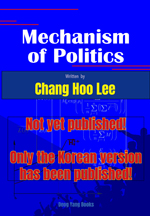| |
Chapter 0. Contents of this
book
(3) Mathematical Model

I pursue a theory that explains political
phenomenon through a quantitative approach while exploring
political phenomenon from a political phenomenological
perspective. The reason for using a quantitative approach
is because it has many benefits. Firstly, it allows
for the collection of appropriate data from many historical
cases. Secondly, it makes theoretical debates clearer.
Thirdly, it enables the discovery of the randomness
of variables in empirical analysis.
The ultimate goal of this quantitative
approach is to explain political phenomenon through
mathematical models, essentially, the mathematization
of politics. As a preliminary step, I will partially
present mathematical models that explain political
phenomenon. However, even if you read this book without
mathematical models, I will arrange it so that there
is no difficulty in understanding the content. To
do this, I will separate the discussion on mathematical
models in each chapter.
Concerned with the immediate goal
of this book, mathematical models are not a large
part. But in the long-term study of politics, the
construction of mathematical models is important.
Therefore, the next publication will present a system
of mathematical politics to explain the majority of
political phenomena. (Most readers who are not political
science majors may not read this book.) To put it
ahead of time, it was necessary to rough out the overall
system of mathematical politics while composing the
mathematical models presented in this book. This is
because if the mathematical models presented later
cannot be connected to each other, it would be a waste.
From an academic or the author's
perspective, considering the logical order, it might
be better to present the system of mathematical politics
first before writing this book. However, from the
reader's perspective, it may be the opposite. Reading
a book about politics filled with mathematical formulas
may not be understandable if the content being explained
is entirely new.
When I began constructing a mathematical
model, many scholars showed a skeptical reaction,
especially when they were well aware of politics.
They said, "Well… if it works well, it
could be a significant work, but it's probably impossible…"
This is a quote from one of the professors at Seoul
National University. The core of this skepticism lies
in quantification. The starting point of mathematical
models is numbers, and the key to political phenomena
must be quantitatively measured. In economics, all
(or at least the essential parts of) economic phenomena
are expressed in terms of money, so it seems possible
to describe them with mathematical models. However,
is the case not the same with political phenomena?
For example, how can the problem of legitimacy be
represented in numbers?
My response to this is that the distinction between
"fact about ideology and ideology as value"
has already been partially explained. Firstly, what
I am trying to explain with the mathematical model
is limited to political phenomena. And the question
of how legitimate any part of someone is, is not the
concern of the mathematical model I am proposing in
this book. Only "who is more persuasive"
is what will be included in the mathematical model.
This is represented as "ideological capacity"
in this book, where the "degree of persuasion"
is shown and can be expressed quantitatively.
How to quantify it specifically is
not discussed in detail in this book, and will be
discussed in the next publication on systematic mathematical
political science. However, even if only a rough understanding
of the content of this book is achieved, it can be
seen that the starting point of the mathematical model
relies on values such as armed capacity, economic
capacity, and ideological capacity. The most difficult
point here is quantifying ideological capacity. However,
we know that people's happiness levels can be quantified
using something like the happiness index. Despite
being known to be imperfect, there still exists a
method of quantification and it has the potential
to be improved in the future. Therefore, it is certain
that the ideological capacity of each political actor
can also be quantified. Once the value of ideological
capacity is measured by a quantifiable method and
adjusted to match the overall theoretical system,
it should be sufficient.
It may not be easy to undertake such
a task, but one thing is clear. It is better to explain
political phenomena through a mathe- matical model
than through complex and vague concepts like they
are explained now. And ultimately, even if it fails,
there is value in trying. This is also why I partially
present the mathematical model in this book.
It may not be an easy task, but one
thing is certain. Using such a mathematical model
to explain political phenomena is better than explaining
them with complex and vague concepts as it is now.
And even if it fails in the end, it is worth trying.
This is also why I partially present the mathematical
model in this book.
  
|